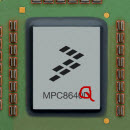 A common question from simulation users to us simulation providers is “can I simulate a machine with N cores”, where N is “large”. As if running lots of cores was a simulation system or even a hardware problem. In almost all cases, the problem is with software. Creating an arbitrary configuration in a virtual platform is easy. Creating a software stack for that arbitrary platform is a lot harder, since an SMP software stack needs to understand about the cores and how they communicate.
A common question from simulation users to us simulation providers is “can I simulate a machine with N cores”, where N is “large”. As if running lots of cores was a simulation system or even a hardware problem. In almost all cases, the problem is with software. Creating an arbitrary configuration in a virtual platform is easy. Creating a software stack for that arbitrary platform is a lot harder, since an SMP software stack needs to understand about the cores and how they communicate.
Essentially, what you need is a hardware design that has addressing room for lots of cores, and a software stack that is capable of using lots of cores — even if such configurations do not exist in hardware. Unfortunately, since software is normally written to run on real existing machines, there tends to be unexpected limitations even where scalability should be feasible “in principle”.
Here is the story of how I convinced Linux to handle more than two cores in a virtual MPC8641D machine.
Continue reading “Three Cores make a Crowd — or a Problem”
 SCDSource ran a short but good article summarizing a few DAC talks that I would liked to attend. it mostly about the experience of long-term parallel programming research David Bailey in presenting results in the field…
SCDSource ran a short but good article summarizing a few DAC talks that I would liked to attend. it mostly about the experience of long-term parallel programming research David Bailey in presenting results in the field… In a post from late June, Jeff Atwood at Coding Horror
In a post from late June, Jeff Atwood at Coding Horror  About two months ago,
About two months ago, 

 A common question from simulation users to us simulation providers is “can I simulate a machine with N cores”, where N is “large”. As if running lots of cores was a simulation system or even a hardware problem. In almost all cases, the problem is with software. Creating an arbitrary configuration in a virtual platform is easy. Creating a software stack for that arbitrary platform is a lot harder, since an SMP software stack needs to understand about the cores and how they communicate.
A common question from simulation users to us simulation providers is “can I simulate a machine with N cores”, where N is “large”. As if running lots of cores was a simulation system or even a hardware problem. In almost all cases, the problem is with software. Creating an arbitrary configuration in a virtual platform is easy. Creating a software stack for that arbitrary platform is a lot harder, since an SMP software stack needs to understand about the cores and how they communicate. The best way to learn something is to try, fail, and then try again. That is how I just learned the basics of multiprocessor interrupt management. For an educational setup, I have been creating a purely virtual virtual platform from scratch. This setup contains a large number of processors with local memory, and then a global shared memory, as well as a means for the processors to interrupt each other in order to notify about the presence of a message or synchronize in general. Getting this really right turned out to be not so easy.
The best way to learn something is to try, fail, and then try again. That is how I just learned the basics of multiprocessor interrupt management. For an educational setup, I have been creating a purely virtual virtual platform from scratch. This setup contains a large number of processors with local memory, and then a global shared memory, as well as a means for the processors to interrupt each other in order to notify about the presence of a message or synchronize in general. Getting this really right turned out to be not so easy. Jack Ganssle
Jack Ganssle